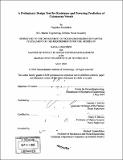| dc.contributor.advisor | Timothy J. McCoy. | en_US |
| dc.contributor.author | Zouridakis, Fragiskos | en_US |
| dc.contributor.other | Massachusetts Institute of Technology. Dept. of Ocean Engineering. | en_US |
| dc.date.accessioned | 2006-07-31T15:15:36Z | |
| dc.date.available | 2006-07-31T15:15:36Z | |
| dc.date.copyright | 2005 | en_US |
| dc.date.issued | 2005 | en_US |
| dc.identifier.uri | http://hdl.handle.net/1721.1/33595 | |
| dc.description | Thesis (Nav. E. and S.M.)--Massachusetts Institute of Technology, Dept. of Ocean Engineering, 2005. | en_US |
| dc.description | Includes bibliographical references (p. 86-87). | en_US |
| dc.description.abstract | During the last decade catamaran ships have been very rapidly evolved into a dominant mode of sea transportation. Their particular area of proliferation is the short sea shipping where they show considerable superiority over competitive designs in attributes such as power requirements, economy, space availability and seakeeping. The rapid growth of the market has led to the need for an expanded range of catamaran designs in terms of size, speed, and payload diversity (passengers, vehicles, containers). However, even now, there is a scarcity of publicly available preliminary design tools for catamarans. This fact hinders the ship owner and naval architect from being able to quickly assess the relative merits of alternative potential designs without having to resort to expensive expert consultancy solutions. Resistance characteristics and power requirements are principal aspects of the catamaran design spiral as they are strongly coupled with speed and fuel economy, and, consequently, the operating and cost efficiencies of the vessel. This thesis aims towards the development of a tool that predicts the resistance and required power for catamaran vessels in the range of 20m to 80m. Vessels with both round bilge and hard chine hulls are considered. | en_US |
| dc.description.abstract | (cont.) Reasonable accurate prediction may be achieved for all speed regions of intended operation. (Displacement, semi-displacement and planning) The user will be able to select both propellers and waterjets for the propulsion of the vessel. For any given vessel size and operational profile the user will be able to determine the most efficient design by altering a series of inputs related to ship geometry and propulsor characteristics. Besides preliminary powering predictions, the tool has the potential to assist in parametric trade-off studies by exploring sets of hull form - propulsor combinations due to its ability to produce variants within a very short time frame. | en_US |
| dc.description.statementofresponsibility | by Fragiskos Zouridakis. | en_US |
| dc.format.extent | 144 p. | en_US |
| dc.format.extent | 7290379 bytes | |
| dc.format.extent | 7296440 bytes | |
| dc.format.mimetype | application/pdf | |
| dc.format.mimetype | application/pdf | |
| dc.language.iso | eng | en_US |
| dc.publisher | Massachusetts Institute of Technology | en_US |
| dc.rights | M.I.T. theses are protected by copyright. They may be viewed from this source for any purpose, but reproduction or distribution in any format is prohibited without written permission. See provided URL for inquiries about permission. | en_US |
| dc.rights.uri | http://dspace.mit.edu/handle/1721.1/7582 | |
| dc.subject | Ocean Engineering. | en_US |
| dc.title | A preliminary design tool for resistance and powering prediction of catamaran vessels | en_US |
| dc.type | Thesis | en_US |
| dc.description.degree | Nav.E.and S.M. | en_US |
| dc.contributor.department | Massachusetts Institute of Technology. Department of Ocean Engineering | |
| dc.identifier.oclc | 63789904 | en_US |
